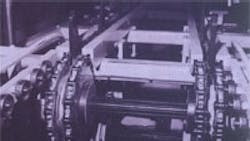What you should know about ball splines
The ball spline allows nearly friction-free linear motion while transmitting torque, whereas a conventional spline must resort to flat metal surfaces sliding on each other. The ball spline is to splines what the ball screw is to machine screws.
Figure 1, next page, shows an example of a ball spline. Here, it consists of the spline, or inner race, and a mating linear bearing, or outer race. The inner race is typically an alloy steel, induction heat treated to 56 to 60 Rc (Rockwell C hardness). Some splines have gothic-arch type ballgroove cross-sections for long life, low rotating lash, and smooth operation.
The outer race is typically of bearing quality steel hardened to 58 to 60 Rc. Recirculating bearing balls in circuits, Figure 1, reduce wear due to friction and allow for unlimited travel. The outer race typically has several active circuits, three or six being typical. Manufacturers offer standard versions and “high-performance” versions for higher-speed, heavyduty applications.
Where you’ll find them
Common ball spline applications include:
• Honing machines.
• Robotics.
• Oil, gas, and water exploration.
• Automation and packaging equipment.
• Medical.
Applications calling for linear movement while restraining the torque resulting from a cantilever load, Figure 2, are excellent uses for ball splines, and many serve in such cases. The maximum force in bending that an assembly can take depends on the diameter of the inner race and the position of the outer race on the inner race when the load is applied. If the load is applied in a cantilever application as in Figure 2, the distance from where the load is applied to the outer race is a factor that must be considered. A unique example of an application of the ball spline is the rotor driveshaft of a helicopter, Figure 3. The ball spline allows free-floating movement of the driveshaft while transmitting driving torque.
The inner and outer races can be modified per customer request. Keyways or setscrew holes for outer races, and journals or threaded ends on inner races, can be machined if needed. If you need extrasmooth motion, close tolerances, and longer life, you can get precision-ground ball splines. Hollow shafts can reduce system weight with little loss in stiffness, a technique also used on some ball screws.
How to select
Selection of the suitable inner and outer race for a specific application involves two interrelated considerations. A change in one can affect the other. The considerations are life expectancy and critical speed. Before selecting a ball spline, the designer must determine the maximum load (lb), desired life (linear travel, in.), speed (rpm), and length between the bearings on the spline (in.). Those conventional units of length and force serve most manufacturers’ calculation procedures.
Life expectancy. The right-size spline will give the life required at the average torque. The chart of Figure 4 relates life (in millions of inches of travel) to operating torque for one manufacturer’s line of standard ball splines. Use the highest torque expected over the length of travel to select the ball spline, ensuring some extra life. The point at which torque load and life requirements intersect is then established. Select the line, representing the specified spline, to the right or above the intersection point.
Critical speed. Your final step is to verify the critical speed of the spline shaft. Critical speed is the maximum speed at which the ball spline can rotate without setting up a spontaneous natural vibration or harmonic. Critical speed varies with diameter, distance between supports, load, rotary speed, and type of bearing supports (end fixity). The four common types of support (much like the possible supports for beam or column calculations) are:
• One end fixed and one end free.
• Both ends simply supported.
• One end fixed and the other simply supported.
• Both ends fixed.
Continue on page 2
Figure 5 relates rotary speed to maximum length between bearings and load for the same manufacturer’s line as that of Figure 4. Use the maximum speed expected when using Figure 5. Spline selection is done in the same manner as it is for life. In general, the higher the degree of end fixity, the larger the shaft diameter, and the shorter the length between bearings and load, then the higher the critical speed. In principle, you want the critical speed to be above the highest expected operating speed. That way, the system never needs to operate close to critical speed, nor to go through it on its way up to operating speed or back down on shutoff.
Shaft straightness and assembly alignment can also affect critical speed. Therefore, it is recommended that you limit maximum speed to 80% of calculated critical speed. If the spline established from the life expectancy chart of Figure 4 and from the critical speed chart of Figure 5 differ, then choose the one of larger shaft diameter.
Other features
Ball splines are efficient. In general, due to rolling instead of sliding friction, a typical coefficient of friction is 0.007 for the manufacturer’s line discussed in this article. Ball splines limit rotational lash to 0.005 to 0.009 in. measured at the ball circle diameter, depending on ball size used in the spline assembly. Outer races can be custom fitted, or selectively fitted, to inner races to minimize rotational lash to within 0.003 in.
Inner races are straight within 0.010 in./ft. They do not exceed 0.030 in./ft in any 6-ft section. Twist is limited to 0.015 in./ft, measured at the major diameter of the spline.
Assemblies operate efficiently between 265 and 300 F with proper lubricants. Lubricants used for rolling-element bearings are recommended, such as light oil or lithium-base grease.
Scott Jindra is Regional Coordinator, Application Engineer, Nook Industries Inc., Cleveland.
Related Articles
Internet resources for motion system design engineers
Articulating motion
